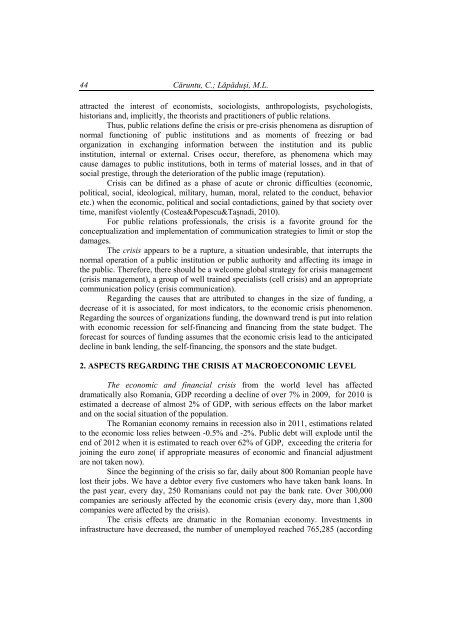annals of the university of petroÅani â¼ economics â¼ vol. xi - part i ...
annals of the university of petroÅani â¼ economics â¼ vol. xi - part i ...
annals of the university of petroÅani â¼ economics â¼ vol. xi - part i ...
Create successful ePaper yourself
Turn your PDF publications into a flip-book with our unique Google optimized e-Paper software.
44 Căruntu, C.; Lăpăduşi, M.L.<br />
attracted <strong>the</strong> interest <strong>of</strong> economists, sociologists, anthropologists, psychologists,<br />
historians and, implicitly, <strong>the</strong> <strong>the</strong>orists and practitioners <strong>of</strong> public relations.<br />
Thus, public relations define <strong>the</strong> crisis or pre-crisis phenomena as disruption <strong>of</strong><br />
normal functioning <strong>of</strong> public institutions and as moments <strong>of</strong> freezing or bad<br />
organization in exchanging information between <strong>the</strong> institution and its public<br />
institution, internal or external. Crises occur, <strong>the</strong>refore, as phenomena which may<br />
cause damages to public institutions, both in terms <strong>of</strong> material losses, and in that <strong>of</strong><br />
social prestige, through <strong>the</strong> deterioration <strong>of</strong> <strong>the</strong> public image (reputation).<br />
Crisis can be difined as a phase <strong>of</strong> acute or chronic difficulties (economic,<br />
political, social, ideological, military, human, moral, related to <strong>the</strong> conduct, behavior<br />
etc.) when <strong>the</strong> economic, political and social contadictions, gained by that society over<br />
time, manifest violently (Costea&Popescu&Taşnadi, 2010).<br />
For public relations pr<strong>of</strong>essionals, <strong>the</strong> crisis is a favorite ground for <strong>the</strong><br />
conceptualization and implementation <strong>of</strong> communication strategies to limit or stop <strong>the</strong><br />
damages.<br />
The crisis appears to be a rupture, a situation undesirable, that interrupts <strong>the</strong><br />
normal operation <strong>of</strong> a public institution or public authority and affecting its image in<br />
<strong>the</strong> public. Therefore, <strong>the</strong>re should be a welcome global strategy for crisis management<br />
(crisis management), a group <strong>of</strong> well trained specialists (cell crisis) and an appropriate<br />
communication policy (crisis communication).<br />
Regarding <strong>the</strong> causes that are attributed to changes in <strong>the</strong> size <strong>of</strong> funding, a<br />
decrease <strong>of</strong> it is associated, for most indicators, to <strong>the</strong> economic crisis phenomenon.<br />
Regarding <strong>the</strong> sources <strong>of</strong> organizations funding, <strong>the</strong> downward trend is put into relation<br />
with economic recession for self-financing and financing from <strong>the</strong> state budget. The<br />
forecast for sources <strong>of</strong> funding assumes that <strong>the</strong> economic crisis lead to <strong>the</strong> anticipated<br />
decline in bank lending, <strong>the</strong> self-financing, <strong>the</strong> sponsors and <strong>the</strong> state budget.<br />
2. ASPECTS REGARDING THE CRISIS AT MACROECONOMIC LEVEL<br />
The economic and financial crisis from <strong>the</strong> world level has affected<br />
dramatically also Romania, GDP recording a decline <strong>of</strong> over 7% in 2009, for 2010 is<br />
estimated a decrease <strong>of</strong> almost 2% <strong>of</strong> GDP, with serious effects on <strong>the</strong> labor market<br />
and on <strong>the</strong> social situation <strong>of</strong> <strong>the</strong> population.<br />
The Romanian economy remains in recession also in 2011, estimations related<br />
to <strong>the</strong> economic loss relies between -0.5% and -2%. Public debt will explode until <strong>the</strong><br />
end <strong>of</strong> 2012 when it is estimated to reach over 62% <strong>of</strong> GDP, exceeding <strong>the</strong> criteria for<br />
joining <strong>the</strong> euro zone( if appropriate measures <strong>of</strong> economic and financial adjustment<br />
are not taken now).<br />
Since <strong>the</strong> beginning <strong>of</strong> <strong>the</strong> crisis so far, daily about 800 Romanian people have<br />
lost <strong>the</strong>ir jobs. We have a debtor every five customers who have taken bank loans. In<br />
<strong>the</strong> past year, every day, 250 Romanians could not pay <strong>the</strong> bank rate. Over 300,000<br />
companies are seriously affected by <strong>the</strong> economic crisis (every day, more than 1,800<br />
companies were affected by <strong>the</strong> crisis).<br />
The crisis effects are dramatic in <strong>the</strong> Romanian economy. Investments in<br />
infrastructure have decreased, <strong>the</strong> number <strong>of</strong> unemployed reached 765,285 (according

















